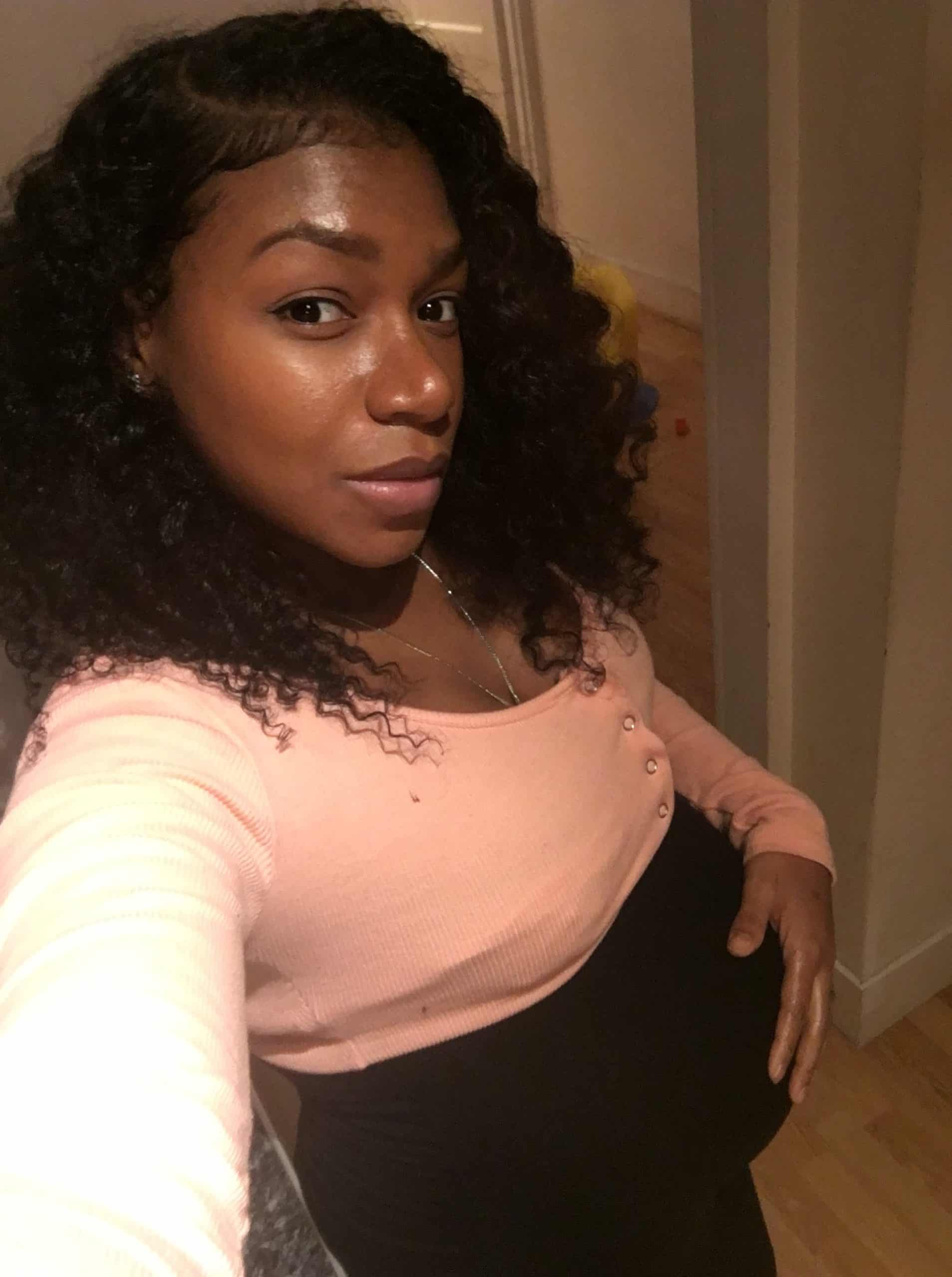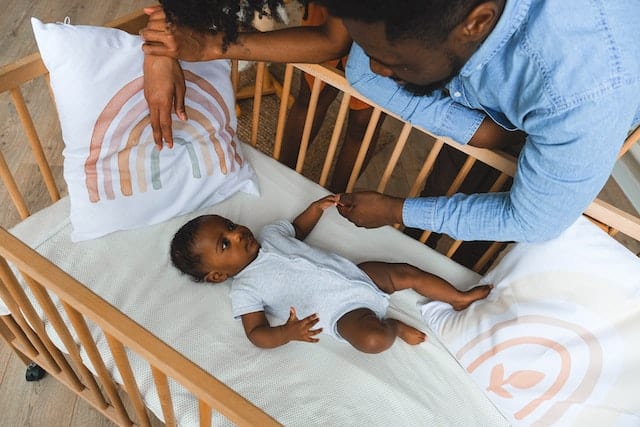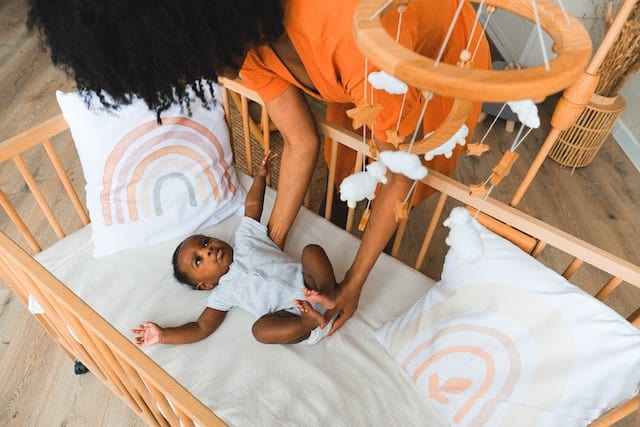Cribs are an essential piece of furniture for parents with young children. They provide a safe and comfortable sleeping environment for infants and toddlers.
However, it’s important to understand the weight limits of a crib to ensure the safety of the child. The weight capacity of a crib can vary depending on several factors, including the material it’s made of, the type of crib, and the manufacturer guidelines.
Understanding the weight limits of a crib is crucial for parents to ensure their child’s safety. The weight capacity of a crib refers to the maximum amount of weight it can support without compromising the structure and stability of the crib.
Exceeding the weight limit can cause the crib to collapse or break, which can lead to serious injuries or even death. Therefore, it’s essential to know the weight limit of a crib and adhere to it.
Key Takeaways
- Understanding the weight limits of a crib is crucial for ensuring a child’s safety.
- The weight capacity of a crib can vary depending on several factors, including the material it’s made of, the type of crib, and the manufacturer guidelines.
- Exceeding the weight limit of a crib can cause serious injuries or even death, so it’s important to know the weight limit and adhere to it.
Learn more in: 5 Signs Your Child Is Ready For A Toddler Bed
Understanding Crib Weight Limits
Crib weight limits are a critical factor to consider when purchasing a crib for your baby. The maximum weight limit determines the amount of weight that the crib can safely hold, ensuring the safety of your baby.
In this section, we will discuss the importance of understanding crib weight limits and what you need to know to ensure your baby’s safety.
The maximum weight limit of a crib is determined by the manufacturer and is usually indicated in the product manual or on the product label. It is essential to follow the weight limit guidelines provided by the manufacturer to ensure that the crib can safely hold your baby’s weight.
Exceeding the maximum weight limit can cause the crib to collapse, leading to severe injuries or even death.
It is important to note that the weight limit of a crib is not just about the weight of your baby. The weight limit also includes the weight of any additional items that may be placed in the crib, such as blankets, toys, or stuffed animals.
These items can add up quickly and can cause the weight limit to be exceeded, putting your baby’s safety at risk.
When selecting a crib for your baby, it is crucial to consider your baby’s weight and the weight of any additional items that may be placed in the crib.
It is also important to choose a crib that has a weight limit that exceeds your baby’s weight to ensure that the crib can safely hold your baby as they grow.
In conclusion, understanding crib weight limits is critical to ensuring your baby’s safety. Always follow the weight limit guidelines provided by the manufacturer and consider the weight of your baby and any additional items that may be placed in the crib.
By doing so, you can ensure that your baby’s crib is a safe and secure place for them to sleep.
Material Impact on Weight Capacity
When it comes to the weight capacity of a crib, the material used in its construction can play a significant role. Different materials have varying levels of strength and durability, which can affect how much weight a crib can safely hold.
This section will explore the impact of materials on weight capacity, specifically wooden and metal cribs.
Wooden Cribs
Wooden cribs are a popular choice for many parents due to their classic look and natural feel. However, the type of wood used in the construction of a crib can affect its weight capacity.
Hardwoods such as oak, ash, American beech, birch, maple, cherry, and mahogany are known for their strength and durability, making them ideal for cribs that need to hold a lot of weight. On the other hand, softwoods like pine may not be as sturdy and should be avoided if weight capacity is a concern.
Another factor to consider is whether the crib is made of solid wood or plywood. Solid wood is generally stronger than plywood, but plywood can still be a good option if it is made from high-quality wood products and is constructed well.
Metal Cribs
Metal cribs are another popular option for parents, and they can be just as strong and durable as wooden cribs. The type of metal used in the construction of a crib can affect its weight capacity, with steel being the strongest option.
However, many metal cribs are made of aluminum, which is lighter and less expensive but may not be as strong.
It’s also important to consider the construction of the crib. Welded joints are generally stronger than bolted joints, and thicker metal tubing can also increase the weight capacity of the crib.
In conclusion, the material used in the construction of a crib can have a significant impact on its weight capacity.
When choosing a crib, it’s important to consider the type of wood or metal used, as well as the construction techniques employed. By doing so, parents can ensure that their baby’s crib is strong, sturdy, and safe.
Types of Cribs and Their Weight Limits
Standard Cribs
Standard cribs are the most popular type of crib. They are designed to hold a baby up to 50 pounds. The weight limit is set to ensure that the crib is strong enough to hold the baby’s weight, even as they grow.
Standard cribs are available in different styles, colors, and materials, so parents can choose the one that best suits their needs and preferences.
When choosing a standard crib, it is important to ensure that it meets the safety standards set by the Consumer Product Safety Commission (CPSC). The crib should have a sturdy frame, with slats that are no more than 2 3/8 inches apart.
The mattress should fit snugly into the crib, with no gaps between the mattress and the sides of the crib.
Mini Cribs
Mini cribs are smaller than standard cribs and are designed for smaller spaces. They are also lighter and more portable than standard cribs. Mini cribs can hold a baby up to 35 pounds.
They are a good option for parents who travel frequently or who live in apartments with limited space.
Mini cribs are also available in different styles, colors, and materials. When choosing a mini crib, it is important to ensure that it meets the same safety standards as a standard crib.
The mattress should fit snugly into the crib, with no gaps between the mattress and the sides of the crib.
Convertible Cribs
Convertible cribs are designed to grow with the baby. They can be converted into a toddler bed, daybed, or full-size bed. Convertible cribs can hold a baby up to 50 pounds, just like standard cribs.
Convertible cribs are available in different styles, colors, and materials. They are more expensive than standard or mini cribs, but they offer more value because they can be used for several years.
When choosing a convertible crib, it is important to ensure that it meets the same safety standards as a standard crib. The mattress should fit snugly into the crib, with no gaps between the mattress and the sides of the crib.
Transitioning from Crib to Toddler Bed
As toddlers grow, they eventually outgrow their cribs and need to transition to a toddler bed. This can be an exciting and challenging time for both the child and the parents.
A toddler bed is typically smaller than a full-size bed and is designed to be low to the ground to prevent falls. It usually has side rails to keep the child from rolling out of bed. Toddler beds come in a variety of styles, including convertible cribs that can be transformed into toddler beds.
When transitioning from a crib to a toddler bed, it is important to make sure that the toddler is ready for the change. Some signs that a toddler is ready for a toddler bed include climbing out of their crib, showing interest in a big kid bed, or being too big for their crib.
Parents can make the transition easier by involving the child in the process, such as letting them pick out their new bedding or helping to assemble the bed. It is also important to establish a consistent bedtime routine to help the child feel secure in their new sleeping environment.
While toddler beds are designed to hold the weight of a toddler, it is important to note that they are not designed to hold the weight of an adult. If a parent needs to lie down with their child, it is recommended to use a full-size bed or daybed instead.
Overall, transitioning from a crib to a toddler bed can be a positive experience for both the child and the parents with proper preparation and communication.
Safety Considerations
When it comes to choosing a crib for a baby, safety is the top priority. Parents should ensure that the crib they choose is safe and sturdy enough to hold the weight of their baby.
Here are some safety considerations to keep in mind:
Weight Limit
Crib manufacturers are required to follow safety standards set by the Consumer Product Safety Commission (CPSC). One of these standards is the weight limit that a crib can hold. The CPSC requires that cribs be able to hold at least 50 pounds.
However, it is important to note that this weight limit is for the entire crib, including the mattress and any accessories.
Mattress Support
The mattress support is an important part of a crib’s structure. It is what holds the mattress in place and supports the weight of the baby. Parents should ensure that the mattress support is sturdy and securely attached to the crib.
They should also check the mattress support regularly to ensure that it is still in good condition.
SIDS Risk
Unsafe sleep environments can increase the risk of Sudden Infant Death Syndrome (SIDS). Parents should ensure that their baby’s crib meets all safety standards and guidelines to reduce the risk of SIDS.
This includes ensuring that the mattress fits snugly in the crib and that the crib is free from any loose or soft bedding.
Regular Inspections
Parents should regularly inspect their baby’s crib to ensure that it is still safe and in good condition. They should check for any loose or broken parts, as well as any signs of wear and tear.
If any issues are found, the crib should be replaced or repaired immediately.
In summary, choosing a safe and sturdy crib is crucial for the safety of babies. Parents should ensure that the crib meets all safety standards and guidelines, regularly inspect the crib, and create a safe sleep environment to reduce the risk of SIDS.
Manufacturer Guidelines and Manuals
Manufacturers provide guidelines and manuals to ensure the safety of infants using their products. These guidelines and manuals include information on the recommended weight limit for cribs. It is important to follow these guidelines to prevent accidents and injuries.
The recommended weight limit for cribs varies by manufacturer, model, and design. Some cribs are designed to hold more weight than others.
It is important to check the manufacturer’s guidelines and manuals to determine the recommended weight limit for a particular crib.
Manufacturers typically provide a maximum weight limit for their cribs. This weight limit includes the weight of the mattress, bedding, and any other items placed in the crib.
It is important to follow this weight limit to prevent the crib from collapsing or becoming unstable.
Parents and caregivers should also be aware of the age and developmental stage of their child when using a crib.
As a child grows and becomes more active, the risk of the crib collapsing or becoming unstable increases. It is important to monitor the weight and activity level of a child to ensure their safety.
In summary, manufacturers provide guidelines and manuals that include information on the recommended weight limit for cribs.
It is important to follow these guidelines to prevent accidents and injuries. Parents and caregivers should also be aware of the age and developmental stage of their child when using a crib.
Buying a Crib: Key Factors to Consider
When it comes to buying a crib, parents want to ensure that their baby is safe and secure while sleeping. One of the most important factors to consider is the weight limit of the crib.
It is crucial to choose a crib that can hold the weight of the baby as well as any additional weight from blankets, toys, or other items in the crib.
Here are some key factors to consider when buying a crib:
Weight Limit
The weight limit of a crib can vary depending on the model and manufacturer. It is important to check the weight limit of the crib before purchasing it.
A standard crib can hold up to 50 pounds, but some cribs can hold up to 100 pounds or more. It is recommended to choose a crib with a higher weight limit to ensure that it can accommodate the baby’s weight as he or she grows.
Material
The material of the crib can also affect its weight limit. Cribs made of solid wood tend to be sturdier and can hold more weight than cribs made of particleboard or MDF.
It is important to choose a crib made of high-quality materials to ensure that it can withstand the weight of the baby and any additional items in the crib.
Safety Standards
When buying a crib, it is important to choose one that meets safety standards set by organizations such as the Consumer Product Safety Commission (CPSC) and the American Society for Testing and Materials (ASTM).
These standards ensure that the crib is safe for the baby and can hold the weight of the baby as well as any additional weight from items in the crib.
Brand Reputation
Choosing a reputable brand can also ensure that the crib is of high quality and can hold the weight of the baby. Brands such as Amazon and Soothe have a reputation for providing high-quality baby products, including cribs.
In conclusion, when buying a crib, parents should consider the weight limit, material, safety standards, and brand reputation to ensure that the crib can hold the weight of the baby and provide a safe and secure sleeping environment.
Additional Crib Features
In addition to the weight capacity of a crib, there are several other features to consider when choosing a crib for your baby. Here are some additional features to keep in mind:
Stabilizer Bars
Stabilizer bars are designed to provide extra support and stability to the crib. They are typically located at the bottom of the crib legs and can help prevent the crib from tipping over. Make sure the crib you choose has sturdy stabilizer bars.
Side Rails
Side rails are an important safety feature of a crib. They should be at least 26 inches high to prevent your baby from climbing out of the crib. Additionally, make sure the side rails are securely attached to the crib and cannot be easily removed.
Softwood
Softwood is a common material used in cribs. However, it is important to note that softwood can be more susceptible to damage and wear over time. If you choose a crib made of softwood, make sure it is constructed well and has a sturdy structure.
Teething Rail
A teething rail is a protective cover that is placed on the top of the crib rails. It is designed to protect the crib from damage caused by your baby’s teething.
Make sure the teething rail is securely attached to the crib and made of a safe, non-toxic material.
Height Restrictions
Some cribs have height restrictions that limit the mattress height adjustment. Make sure the crib you choose has a range of mattress height adjustments to accommodate your growing baby.
Structure
The overall structure of the crib is also an important factor to consider. Make sure the crib has a sturdy and solid construction with no loose or wobbly parts.
Standard-Sized Cribs
Standard-sized cribs are designed to fit a standard-sized crib mattress. Make sure the crib you choose is compatible with a standard-sized mattress.
Height Limit
Most cribs have a height limit that specifies the maximum height of a child who can use the crib. Make sure the crib you choose has a height limit that will accommodate your child as they grow.
Crib Materials
Cribs can be made from a variety of materials, including wood, metal, and plastic. Make sure the materials used in the construction of the crib are safe and non-toxic for your baby.
Frequently Asked Questions
What is the weight limit for a Delta crib?
The weight limit for Delta cribs varies depending on the model. It is recommended to check the manufacturer’s guidelines for the specific crib you own. However, most Delta cribs have a weight limit of 50 pounds.
What is the weight limit for a Graco crib?
The weight limit for Graco cribs also varies depending on the model. It is best to consult the manufacturer’s guidelines for the specific crib you own. However, most Graco cribs have a weight limit of 50 pounds.
What is the height and weight limit for a crib?
The height and weight limit for a crib also varies depending on the model and manufacturer. It is recommended to check the manufacturer’s guidelines for the specific crib you own. However, most cribs have a weight limit of 50 pounds and a height limit of 35 inches.
What is the weight limit for a Babyletto crib?
The weight limit for Babyletto cribs varies depending on the model. It is best to consult the manufacturer’s guidelines for the specific crib you own. However, most Babyletto cribs have a weight limit of 50 pounds.
How much weight can a toddler bed hold?
Toddler beds are designed to hold up to 50 pounds. However, it is recommended to check the manufacturer’s guidelines for the specific toddler bed you own.
Can I lay in the crib with my baby?
It is not recommended for adults to lay in a crib with a baby due to safety concerns. Cribs are designed to hold infants and young children, not adults.
Related Post: When To Lower Crib?

Iesha is a loving mother of 2 beautiful children. She’s an active parent who enjoys indoor and outdoor adventures with her family. Her mission is to share practical and realistic parenting advice to help the parenting community becoming stronger.



